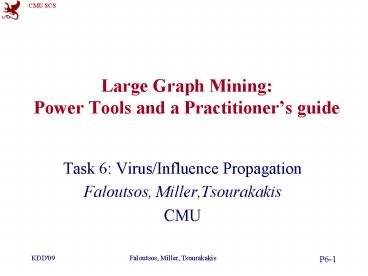P61 PowerPoint PPT Presentation
1 / 28
Title: P61
1
Large Graph MiningPower Tools and a
Practitioners guide
- Task 6 Virus/Influence Propagation
- Faloutsos, Miller,Tsourakakis
- CMU
2
Outline
- Introduction Motivation
- Task 1 Node importance
- Task 2 Community detection
- Task 3 Recommendations
- Task 4 Connection sub-graphs
- Task 5 Mining graphs over time
- Task 6 Virus/influence propagation
- Task 7 Spectral graph theory
- Task 8 Tera/peta graph mining hadoop
- Observations patterns of real graphs
- Conclusions
3
Detailed outline
- Epidemic threshold
- Problem definition
- Analysis
- Experiments
- Fraud detection in e-bay
4
Virus propagation
- How do viruses/rumors propagate?
- Blog influence?
- Will a flu-like virus linger, or will it become
extinct soon?
5
The model SIS
- Flu like Susceptible-Infected-Susceptible
- Virus strength s b/d
Healthy
N2
N
N1
Infected
N3
6
Epidemic threshold t
- of a graph the value of t, such that
- if strength s b / d lt t
- an epidemic can not happen
- Thus,
- given a graph
- compute its epidemic threshold
7
Epidemic threshold t
- What should t depend on?
- avg. degree? and/or highest degree?
- and/or variance of degree?
- and/or third moment of degree?
- and/or diameter?
8
Epidemic threshold
- Theorem 1 We have no epidemic, if
ß/d ltt 1/ ?1,A
9
Epidemic threshold
- Theorem 1 We have no epidemic (), if
epidemic threshold
recovery prob.
ß/d ltt 1/ ?1,A
largest eigenvalue of adj. matrix A
attack prob.
Proof Wang03 () under mild,
conditional-independence assumptions
10
Beginning of proof
details
- Healthy _at_ t1
- - ( healthy or healed )
- - and not attacked _at_ t
- Let p(i , t) Prob node i is sick _at_ t1
- 1 - p(i, t1 ) (1 p(i, t) p(i, t) d )
- Pj (1 b aji p(j ,
t) ) - Below threshold, if the above non-linear
dynamical system above is stable (eigenvalue of
Hessian lt 1 )
11
Epidemic threshold for various networks
- Formula includes older results as special cases
- Homogeneous networks KephartWhite
- ?1,A ltkgt t 1/ltkgt (ltkgt avg degree)
- Star networks (d degree of center)
- ?1,A sqrt(d) t 1/ sqrt(d)
- Infinite power-law networks
- ?1,A 8 t 0 Barabasi
12
Epidemic threshold
- Theorem 2 Below the epidemic threshold, the
epidemic dies out exponentially
13
Detailed outline
- Epidemic threshold
- Problem definition
- Analysis
- Experiments
- Fraud detection in e-bay
14
Current prediction vs. previous
Number of infected nodes
PL-3
Our
Our
ß/d
ß/d
Oregon
Star
- The formulas predictions are more accurate
15
Experiments (Oregon)
b/d gt t (above threshold)
b/d t (at the threshold)
b/d lt t (below threshold)
16
SIS simulation - infected nodes vs time
above
Log - Lin
at
inf. (log scale)
below
Time (linear scale)
17
SIS simulation - infected nodes vs time
above
Log - Lin
at
inf. (log scale)
below
Exponential decay
Time (linear scale)
18
SIS simulation - infected nodes vs time
above
Log - Log
at
inf. (log scale)
below
Time (log scale)
19
SIS simulation - infected nodes vs time
above
Log - Log
at
inf. (log scale)
below
Power-law Decay (!)
Time (log scale)
20
Detailed outline
extra
- Epidemic threshold
- Fraud detection in e-bay
21
E-bay Fraud detection
extra
w/ Polo Chau Shashank Pandit, CMU
NetProbe A Fast and Scalable System for Fraud
Detection in Online Auction Networks, S. Pandit,
D. H. Chau, S. Wang, and C. Faloutsos (WWW'07),
pp. 201-210
22
E-bay Fraud detection
extra
- lines positive feedbacks
- would you buy from him/her?
23
E-bay Fraud detection
extra
- lines positive feedbacks
- would you buy from him/her?
- or him/her?
24
E-bay Fraud detection - NetProbe
extra
Belief Propagation gives
25
Conclusions
- ?1,A Eigenvalue of adjacency matrix
determines the survival of a flu-like virus - It gives a measure of how well connected is the
graph ( paths see Task 7, later) - May guide immunization policies
- Belief Propagation a powerful algo
26
References
- D. Chakrabarti, Y. Wang, C. Wang, J. Leskovec,
and C. Faloutsos, Epidemic Thresholds in Real
Networks, in ACM TISSEC, 10(4), 2008 - Ganesh, A., Massoulie, L., and Towsley, D., 2005.
The effect of network topology on the spread of
epidemics. In INFOCOM.
27
References (contd)
- Hethcote, H. W. 2000. The mathematics of
infectious diseases. SIAM Review 42, 599653. - Hethcote, H. W. AND Yorke, J. A. 1984. Gonorrhea
Transmission Dynamics and Control. Vol. 56.
Springer. Lecture Notes in Biomathematics.
28
References (contd)
- Y. Wang, D. Chakrabarti, C. Wang and C.
Faloutsos, Epidemic Spreading in Real Networks
An Eigenvalue Viewpoint, in SRDS 2003 (pages
25-34), Florence, Italy

